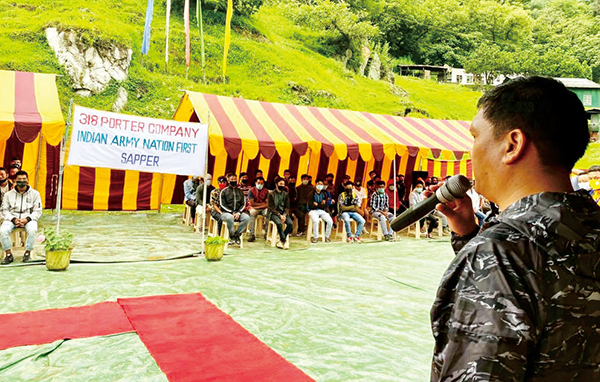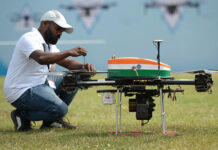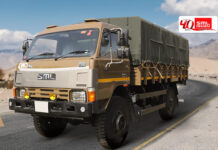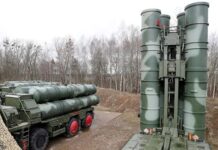Clash in Ladakh Galvanises Procurement
Loitering Munition
After the Indian army brought Spike Mark III anti-tank guided missiles from Israel as part of emergency purchases due to the Ladakh standoff with China, it is now buying state-of-the-art Israeli Spike Firefly “loitering” munition that can deliver a precision strike on enemy troops hiding within a range of one km. The latest Firefly ammunition not only has loitering capability to locate a target but also can be called back if the target has moved beyond range.
Hand-launched UAV
The army also wants 200 pieces of hand-launched, remotely controlled RQ-11 Raven unmanned aerial vehicle (UAV), which can fly up to 10 kilometers at an altitude of 500 feet and speed up to 95 kilometre per hour, to help infantry troops conduct reconnaissance of the battle theatre ahead and placement of enemy troops.
The RQ-11 Raven is a lightweight, low-altitude, remote-controlled, man-portable UAV that can perform intelligence, surveillance, target acquisition and reconnaissance (ISTAR) operations. The UAV captures and transfers medium-resolution imagery to a ground control unit through a digital data link.
Flying at an altitude of 100ft to 500ft, the Raven UAV provides real-time colour or infra-red imagery to the ground control and remote viewing units. It aids in offering surveillance and target acquisition over a large area while presenting infra-red laser rays illuminated or emitted by the ground targets.
Mobile Integrated Network Terminals
The Indian Army has launched a procurement project for the design and development of a Mobile Integrated Network Terminal (MINT) for high altitude deployment under an industry-funded indigenous programme. The Army has projected a requirement of 129 MINT systems along with satellite hubs over the next five years. The responses to the Expression of Interest (EOI) issued on 6 July should be submitted by 3 August.
The secure mobile network will be used in mountainous and high altitude terrain for seamless communication between Indian soldiers and their commanders for better operational efficiency.
According to the EOI documents, the objective is to seek the willingness of Indian vendors to participate in a ‘Make-II‘ project under the amended Chapter IIIA of the Defence Procurement Procedure of 2016.
“Indian vendors meeting the Technical, Commercial, and Project requirements laid out in the EOI will be, as the next step, issued a ‘Project Sanction Order‘ to develop a prototype on ‘No Cost – No Commitment‘ (NCNC) basis. All trials of the project will be on NCNC basis,” according to the EOI document.
“The project is sponsored by the Directorate General of Signals of the Indian Army. The MINT is proposed as a lightweight, portable and easy-to-configure communication system with integral satellite back haul and Field Wireless System (FWS) for employment in mountainous, semi-mountainess and high altitude terrain.”
The FWS would be based on a wireless access system (4G equivalent or better). At user end, a single hand-held device, with support for voice, video and data services, is proposed.
The system is required in a maximum of five transportable ruggedised cases to include the following:
• FWS system and handsets.
• Satellite backhaul.
• IP exchange with support for at least 16 ports.
• Power system.
• Antennae assembly
The Make-II (Industry Funded) project will be processed in accordance with Para 6, Chapter IIIA of the DPP 2016. It will be a Buy (Indian – IDDM) with minimum of 40 per cent Indigenous Content.
Arms for Special Forces
Media reports have surfaced about the Army going in for 7.62 x 51 mm FN Scar, made by a US unit of Belgium’s FN Herstal, under its own financial powers and which is likely to cost around Rs 200-300 crore.
The 7.62 x 51 mm FN Scar, is going to help in the upgrading of the firepower of SF in the dense jungles of the Northeast and Myanmar. These small weapons are considered to be of critical value for the Special Forces as support weapons enabling them with heavy firepower.
The modernization of the Special Forces has been pending since 2005 and last year a decision was taken to start the process gradually of the Special Forces and a decision to procure from the US through the FMS route was taken.
There is an urgent requirement of 20 million rounds of ammunition. These will be used in the small arms.
The wish list of Special Forces includes
• 715 Mk 48 Light Machine Guns (LMGs).
• 1,050 FN Scar (H) 7.62×51 assault rifles,
• 1,400 FN Scar (L) or HK-416 assault rifles,
• 110 .50 Cal Browning heavy machine guns (HMG),
• 400 helmet-mounted night vision systems
• 600 combat free fall parachutes
• 100 Barret M107 A1 heavy sniping rifles
Riot Gear for Soldiers
The Army has ordered body protective suits and batons for troops deployed along the Line of Actual Control (LAC) in eastern Ladakh, the focus of current tensions with China, to protect them from assaults by Chinese troops.
The Chinese troops have been using stones, iron rods and nail-studded clubs to inflict serious injuries during border brawls. Twenty Indian soldiers, including a colonel, were killed in a seven-hour brawl in Ladakh’s Galwan Valley on 15 June. The Army retaliated and killed over 40 Chinese soldiers in hand-to-hand fight.
The soldiers along the LAC will get 500 sets of protective suits soon in the first instalment. The army has ordered a total of around 2,000 sets of protective suits and batons.
Excalibur Ammunition for M777 Howitzers
India is going to place orders for more Excalibur precision-guided ammunition for M-777 Howitzer guns from the United States under the emergency financial powers granted to the armed forces by the Centre. The Excalibur ammunition has more range and better accuracy that makes it lethal can hit targets at 40-50 km depending on the artillery gun used.
India had first placed an order for the Excalibur ammunition in May-June last year after the Balakot operations.
The government had granted enhanced financial power to the defence forces under which they can buy any weapon system under Rs 500 crore under emergency procedure. Under these powers, the defence forces, in consultation with the Department of Military Affairs, can go in for buying any weapon which they feel would be required for warfighting or are short of in their inventory.
No Extension for 41,000 LMG Bid
The process for the acquisition of LMGs, approved in 2018, is expected to cost Rs 3,000 crore and will not be delayed. No extension is planned. The procurement involves local manufacture of around 41,000 LMGs with the absorption of all critical technologies and is being attempted for the first time. These 7.62×51 mm LMGs are going to help in bolstering the firepower of infantry soldiers who are deployed along borders with China and Pakistan.
A number of Indian vendors have represented to the Ministry of Defence (MoD) seeking the extension of bid submission date for the Light Machine Gun (LMG) programme under the `Make in India’ initiative. Key competitors for this programme include Adani Group, Bharat Forge, Megha Engineering and others.
Due to global pandemic of COVID-19 everything had been put on hold including RfPs for various programmes. Two independent bids for Night Vision Devices were given an extension until July end and a notable exception was the LMG programme.
As per the tender these LMGs are expected to have telescopic sight with 4 x magnification and should have the capability to facilitate engagement of human target at 1000m. They are for equipping the infantry battalions.
======================
Operational Moves to Counter Chinese
Both India and China have significantly reinforced their deployments with thousands of soldiers, fighter jets, helicopters, tanks, heavy artillery, missiles and air defence systems in the region, as attempts to reduce tensions have not yielded a breakthrough.
The Army has moved three divisions, several squadrons of frontline tanks, additional artillery pieces and fully-ready mechanised infantry squads to the Ladakh sector, as part of its efforts to strengthen its deployments in response to fortified Chinese military presence in the region.
The three army divisions sent to build the necessary military strength to deter possible aggressive moves by the Chinese forces deployed across the contested Line of Actual Control (LAC) account for up to 30,000 well-trained soldiers, as high-altitude deployments are being bolstered with sharp focus on contingency planning.
A large number of the troop reinforcements sent to Ladakh have been drawn from the army’s reserve formations, based in a mountainous region in north India.
While the reserve formations have moved with their own integral artillery elements, the tanks and the infantry combat vehicles have been marshalled from multiple bases across the western sector for force augmentation in Ladakh.
Diverting these forces and this equipment would not make any “elemental difference” to the situation on the western front.
India has also deployed its air defence weapon systems to counter possible aerial threats from the PLA-Air Force in the Ladakh sector where tensions rose sharply after a in Galwan Valley on 15 June. The IAF has raised its guard to deal with any military provocation by the Chinese forces and forward bases have been ordered to be on their highest state of alert.
Porter Companies Raised
A porter-raising ceremony was organised by the Army’s 22 Mahar Regiment in West Kameng district on July 3, 2020. It was attended by the chief minister Pema Khandu.
The raising of the porter companies was significant. Days after the stand-off between Indian and Chinese soldiers at Galwan Valley in Ladakh, the Indian Army began the process of employing 1,800 porters temporarily in Arunachal Pradesh.
Three companies would be raised in coordination with the State’s Labour Department. One of these companies is for Tawang region that has been central to China’s claim over the State since the 1962 aggression.
The Army periodically takes in porters for about six months to carry essentials and equipment to and from forward posts in the high altitudes across the Himalayan belt. Each porter is “treated like a soldier” during his tenure, renewable depending upon the need for their services.
Although the Army has mules, porters are indispensable for logistic support in areas where vehicles cannot go. Fit locals acquainted with terrain and climatic conditions are assets, and their services are renewed on requirement particularly during the winter season.



















[…] ALSO READ ARMY MODERNISATION: Army to Buy Smart Munitions, UAVs, Riot Gear Under Fast Track […]